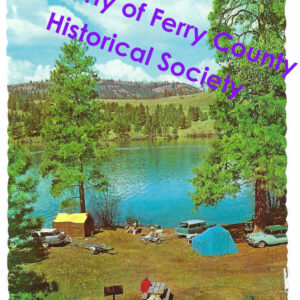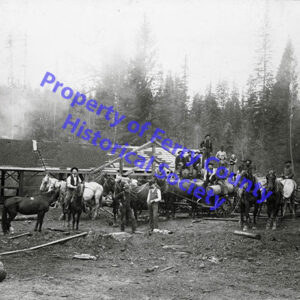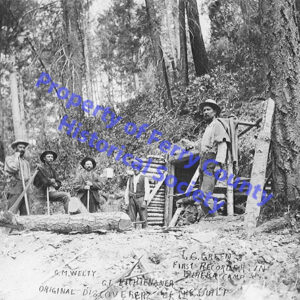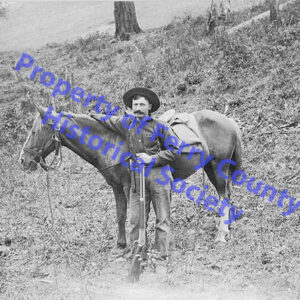The following article by William Compton Brown, locally known as “Judge Brown” for his later judicial career, was published in the Republic News-Miner on September 20, 1923.
How the San Poil Received its Name
Recently the News received a letter from a prominent Washington educator containing an inquiry as to the origin of the name of the San Poil river. Not being well versed in local history and lacking the facilities for making any extensive research work, we sent out and s. o. s. with most interesting results.
Attorney Charles P. Bennett noticed our appeal and came into our office the next day after publication, telling us something of the origin of the name and promising to look up the details for us. Accordingly he wrote to Attorney William C. Brown, of Okanogan, in regard to the matter.
Following is the most interesting reply of Mr. Brown, who is well versed in local history.
“Friend Bennett: I just received your letter relative to the derivation of the word “San Poil.” As this is Sunday, I will look the matter up a little to refresh my memory and write you at once, otherwise the letter is likely to be put off and perhaps never written.
The name “San Poil” is derived from the Indian name of the river that now bears the name. The Indian is “Sin-po-ell,” with the accent on the first and last syllables. It was also the name of the Indians living on the lower part of the river. In fact, it is the name of a tribe of Indians that lived on the San Poil river and had their headquarters and principal camping place near the mouth thereof. But some Indians have told me that the name of the river was “Sin-po-ell” and the name of the tribe was “Sin-po-ell-ucks.”
I will endeavor to give you a hop skip and jump history of the evolution of the name. As far as we know the first man that ever put the name down in writing was Alexander Henry, for we find in his famous journal an extensive entry, apparently made some time in the late winter or early spring of 1811, which contains an extensive disnertation upon the various tribes which the Northwest Company was then in contact with west of the Rocky Mountains, and in the course of his general review he says after discussing the Spokanes, Coeur d’Alenes, Flat Heads and others the following, viz:
“The Sinpoils, or, as they call themselves Spoil-Ehiehs are also a tribe of Flat Heads (i. of the Salishan family) and speak nearly the same language. They live somewhat further westward (than the Spokanes) on the river that falls into the Columbia and is noted for its salmon fisheries. Our people settled an establishment on this river in the summer of 1810 where they met many Indians who came to them from the S and W bringing beavers, bears, otters and other valuable skins to trade and telling us that their own country abounded with these animals. They also brought many horses, on which they appear to set no great value. The character of those strangers (that is the Indians from the south and west that came to trade) did not appear so mild and docile as that of the other Flat Head tribes. Their behgavior was more haughty and independent though in the main they were peacable and favorably inclined toward us. The Simpolis seldom leave their own country and like their neighbors the Spokanes live upon the product of their own lands and vast quantities of fat, well flavored salmon which they take in their river.
Alexander Henry wrote the above at his post on the upper Saskatchewan but the man was wonderfully accurate in all his statements and when he says that the traders of the Northwest Company was on the “Simpoil” river and traded there in the summer of 1810 it is undoubtedly true but his statement that they “settled an establishment on this river” must be held to mean merely a temporary building of boughs or bark or something like that or more likely a tent for when Thompson arrived at the mouth of that river in July 1811 he makes no mention of any building. These traders were probably led by Jacques Finlay and McDonald for both these “Northwesters” were in the Spokane country in the summer of 1810.
We next find the name committed to the written page when that wonderful “Northwester” David Thompson made his famous dash down the Columbia the summer of 1811 in the interests of the N. W. Co.
Thompson with his party left Kettle Falls in a big canoe at 6:30 A. M. July 3rd, 1811, and arrived at the Indian camp half a mile up the San Poil at 4:45 in the afternoon of the same day. This record shows the kind of canoemen those old timers were. We would have to have a good gasoline launch to make that run today in that space of time.
Thompson had with him in the canoe two “Simpoil” Indians as guides and interpreters. These Indians he apparently picked up at Kettle Falls and these Indians must have been in the employ of the company since the year before at least for it seems they spoke either some French or some English.
This is what Thompson wrote in his journal in recording what happened when the canoe reached the mouth of the San Poil river:
“turned and went up the brook from the right to the camp of the Simpoil Indians, north one-half mile, put ashore at 4 forty five P. M. but finding the place dirty went about a quarter of a mile further to a good encampment…”From 11 A. M. to the Simpoil camp the river presented much steep rock…On our arrival at the Simpol camp we pitched our tents. No one approached us till we sent for them to come.”
Thompson goes on and makes a very extended entry in regard to his visit at the “Simpoil” camp describes how the Indians danced for them and made presents of dried salmon, roots and berries. He says the Indians were poorly clothed and that they were too poorly armed to obtain any spoil of worth from the chase. Thompson and his party did not leave until about noon on July 4th to proceed down the Columbia.
Alexander Ross was much at Fort Okanogan from 1811 to 1816 and he writes of the various branches of the “Oakinacken” Indians and among others he mentions the “Sin-poh-ell-ech-ach” which is his understanding of the name of the Indians on what we now call the San Poil. Later Cox mentions them. He was in charge at Ft. Okanogan in 1826 and some San Poil Indians came over and stole some horses belonging to the fort. He calls them the “Sinapoil” Indians.
And so the mention runs down through the years. There are more different spellings than there are letters in the name.
But now as to the how the name got its present form. Most of the men working for the Northwest Co., the Astor Co. and the Hudson Bay Co. were Canadian Frenchmen. They were always quick to pun on a name. They began calling the river and the Indians along it Sans Poil (No hair and Cieq Poil (Five hairs) for the Indian name was very nearly the same as these word in French. Then came the modern Government map makers and they took in earnest what the French voyagers of the trade had use as a joke and a pun and put it down on the maps as “Sans Poil”. I believe Symons did this. Then the later people thinking it must be one of the names like California has with San this and San that, dropped the s and at last the name has evolved into San Poil.”
This explanation has already run into great length so I will cut it short right here.
Yours Truly,
W.C. Brown
Ethnographer Verne F. Ray, who worked with Sanpoil and Nespelem people in the 1930s, in the Pacific Northwest Quarterly in 1936, gives the name of the “Sanpoil” people as “snpui·′l ͧ,” which, he writes, means “people of the gray country”. (Ray 1930 page 122). The website of the Confederated Tribes of the Colville Reservation gives the name in IPA script, which this computer can’t handle, and states that it means “Gray as far as the eye can see”.
Ray, Verne F
1930 Native villages and Groupings of the Columbia Basin. Pacific Northwest Quarterly
27:2, pages 99-152. University of Washington, Seattle.
Judge William Compton Brown (1869-1963) wrote many newspaper articles and other publications on the history of northeastern and central Washington State including two books, The Indian Side of the Story and Mary Moses’ Statement.




